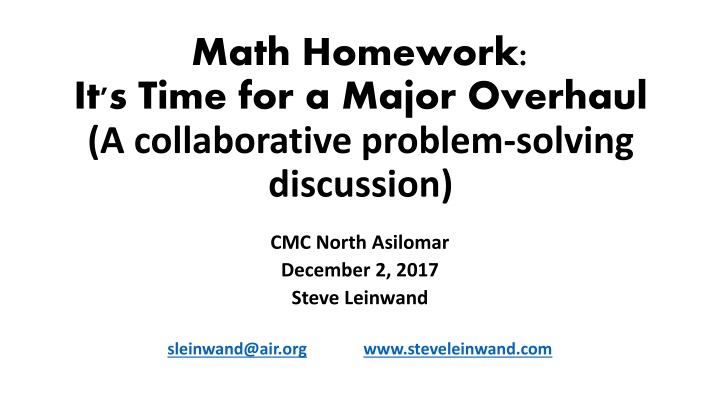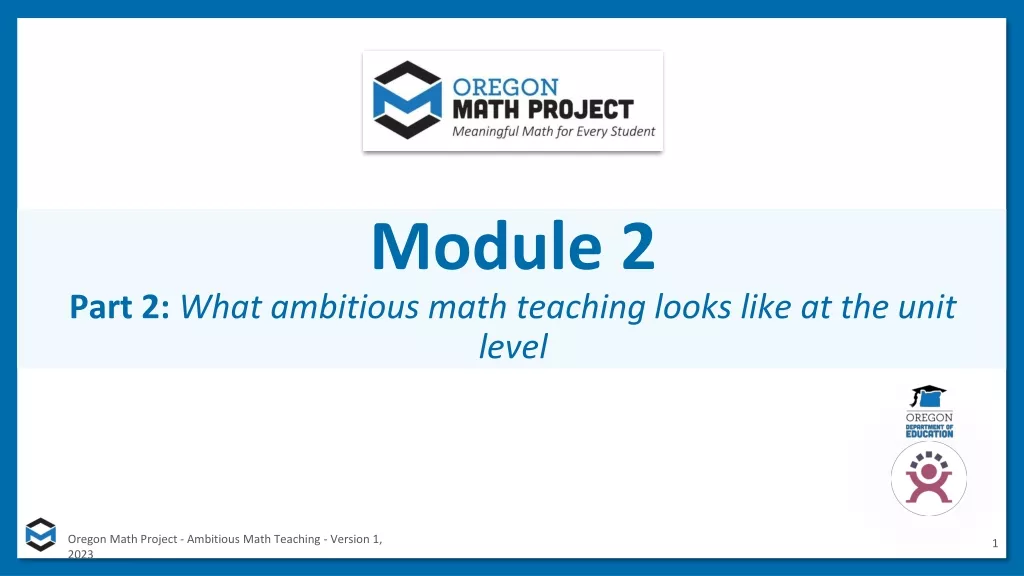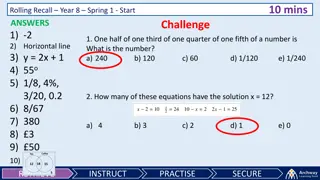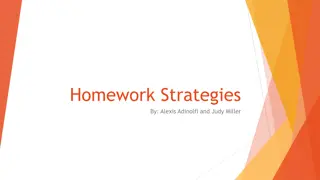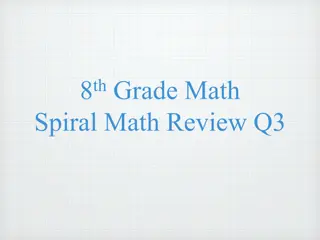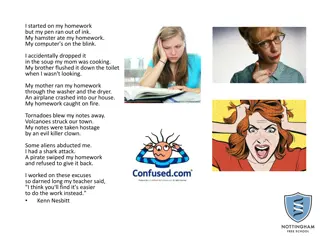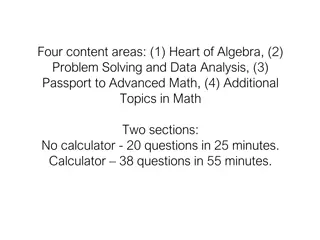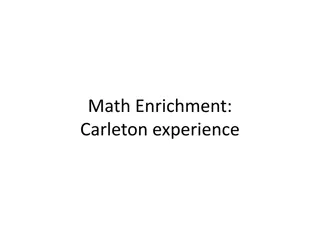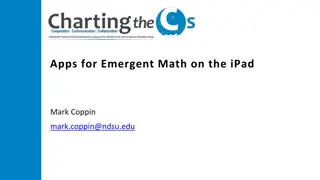Collaborative Problem-Solving in Math Homework Overhaul
Join the discussion on reshaping math homework to enhance learning outcomes with collaborative problem-solving strategies. Explore alternatives to traditional assignments and analyze the effectiveness of different approaches. Dive into practical examples and insights shared by Steve Leinwand at CMC North Asilomar in December 2017.
Download Presentation

Please find below an Image/Link to download the presentation.
The content on the website is provided AS IS for your information and personal use only. It may not be sold, licensed, or shared on other websites without obtaining consent from the author.If you encounter any issues during the download, it is possible that the publisher has removed the file from their server.
You are allowed to download the files provided on this website for personal or commercial use, subject to the condition that they are used lawfully. All files are the property of their respective owners.
The content on the website is provided AS IS for your information and personal use only. It may not be sold, licensed, or shared on other websites without obtaining consent from the author.
E N D
Presentation Transcript
Math Homework: It's Time for a Major Overhaul (A collaborative problem-solving discussion) CMC North Asilomar December 2, 2017 Steve Leinwand sleinwand@air.org www.steveleinwand.com
3:30 pm Welcome to Saturday Detention
How I tend to operate: How I tend to operate: 1000 classroom observations since 2010 A Problem. Hmmm Ponder at 37,000 feet Write some notes Do some reading Write some more notes Write and/or speak to organize my thinking Share Stimulate So here we are See also: http://steveleinwand.com/publications/
What could be more American than: What could be more American than: Mom Apple pie Math homework
In fact, what is more inevitable than: Death Taxes Math homework
So to begin: So to begin: 1. Turn and describe the math homework you assigned this past week. 2. Turn and tell your partner what the purpose of this homework was.
How many tasks/problems? With what balance? For what purpose? Reviewed how? How well did it support LEARNING???
So lets compare two homework assignments So let s compare two homework assignments Page 128 1-19 odd
Page 128 1 Page 128 1- -19 odd 19 odd How close or how far from what is typical? What is purpose? What are benefits?
An alternative An alternative compliments of Homework: a, b, c, d, e and f are six unique one digit numbers. compliments of OpenMiddle OpenMiddle What replacements for these letters make the expression shown closest to 1? a . c . e b d f Can you make the expression exactly equal to 1?
a, b, c, d, e and f a, b, c, d, e and f How close or how far from what is typical? What is purpose? What are benefits?
My serious query: My serious query: Why do we continue to put tradition ahead of research and common sense? Because that is what we do most days when it comes to math homework!
Lets be honest: Let s be honest: There is little that wastes more time in students lives, in class and at home, than assigning, completing and reviewing math homework. Not convinced?
The heart of the matter: The heart of the matter: If the point of homework is to see if students get it, then 5 practice problems is enough. If kids get it after 5 problems, and you ask them to do another 35, you re just being mean. And if kids don t get it after 5 problems, and you ask them to do another 35, you re really being mean. - Matt Cwalina, Discovery Education
Some estimates of the waste Some estimates of the waste 45,000,000 grades 2-12 students x (30 mins to do + 10 mins to go over in class) = 30 million hours/day. Assume 50% isn t wasted and that HW is assigned 140 days per year: Each student wastes 20 mins x 140 days = 47 hours/year = 6 eight hour days each year!!! Think about what we could teach or do when we multiply this by 45,000,000.
Look at what Look at what WE WE do: do: We spend precious minutes assigning homework and expecting our student to copy the assignment down. We expect students to spend between 30 and 45 minutes each school night except Friday doing homework, usually regurgitating procedures and mimicking from notes and text. We spend somewhere between 10 and 20 minutes going over the homework in class. A typical assignment: 247 243 239 1-19 odd 2-20 even 32, 34, 38 All for what real value?
Look at what Look at what THEY THEY do: do: Copy their homework from friends; Do their homework in groups, wisely allocating the exercises; Use homework apps that deliver answers; Regularly blow it all off rarely do as many as 50% actually take out their homework. Fights at home alienate parents adversary roles with parents Tension between home and school They make a slew of mistakes and all we do is attend to answers and correct procedures Nonsense Reinforces I m dumb Exacerbates class cutting Changes their perception of math SPEED AND ACCURACY vs PS and REASONING
But look at what we know: But look at what we know: - Distributed practice is far more effective that clumped practice. - So much of what is taught today is lost by next week or 10 minutes after the next test because it is placed in short-term memory, not based on understanding and not reviewed systematically over time. - A balanced program (a rigorous program) includes skills, concepts and applications, BUT, the vast majority of homework is SKILL practice. - A math program should address the Common Core Standards for Mathematical Practices, but where is there anything except PRECISION in most assignments?
What else do we know? What else do we know? For students: Homework is often frustrating when it is either so repetitious or non-understandable; Reduces time for other far more rewarding activities ( You can t until you finish your homework. ); Reduces interest in learning when most of the work is so mind- numbing. As parents: Nag, feel inadequate, play enforcer, worry about how much to help; Be subversive life in the Leinwand household ca. 1998.
Look at the research: Look at the research: Consider the results of the 2000 math exam. Fourth graders who did no homework got roughly the same score as those who did 30 minutes a night. Remarkably, the scores then declined for those who did 45 minutes, then declined again for those who did an hour or more! In eighth grade, the scores were higher for those who did between 15 and 45 minutes a night than for those who did no homework, but the results were worse for those who did an hour s worth, and worse still for those did more than an hour. In twelfth grade, the scores were about the same regardless of whether students did only 15 minutes or more than an hour. - Alfie Kohn
In summary: In summary: There is no evidence that homework has a positive impact on student achievement in grades K-8 and there is only a slight impact on student achievement in 9-12.
So what are rational alternatives? So what are rational alternatives? Purpose Number of tasks Maximum time to complete Communicating the assignment Checking, not grading or correcting Feedback
The purpose of math homework The purpose of math homework Do a small amount of independent practice: - on the new skill and/or concept - of previously taught content - on some of the practices Extend classroom time beyond mathematics class Provide an opportunity for students to feel like they have actually learned something It is reflective draws on metacognition What did you learn today Develop ownership over their own learning Opportunity to show their thinking and the difference Preparation for what is coming diagnostic/readiness Opportunity to make learning real vs. just more regurgitation
2 2- -4 4- -2 Homework Policies 2 Homework Policies 2 problems on the new skill (which is usually enough to determine understanding and avoids such much practice of mistakes that it is hard to unlearn them); 4 cumulative review problems roughly drawn from the day before, the week before, last month and perhaps a diagnostic readiness check for the next lesson - all of which honor distributive practice; and 2 problems that require showing work or explanation and support problem solving and reasoning and justification.
But what good is practice without feedback? But what good is practice without feedback? After beginning mathematics the next day, teachers can easily post the answers to these 8 exercises or problems on the white board and provide students with 5 minutes to review their work in pairs or triads with particular attention to the last two problems. Classroom policy can then be that correct work for any problems that are still causing trouble can be easily displayed with a document camera and discussed before homework is collected, only to be recorded as completed. Turn and tell your partner about some ALTERNATIVES YOU VE SEEN OR TRIED?
Priming the discussion pump: Priming the discussion pump: Email homework Post HW to class twitter account Send textbooks home on day 1 and use for homework Now, turn and tell your partner what other options improve the value of homework.
Alternatives/variations/proposals from the group Alternatives/variations/proposals from the group More than just one night. You have a week to do the assignment! Ask them to process the problem questions about the context and the math, not just or even the answer Homework is to do the problem set-up, not the solving!!! Look at each others work gallery work without names Provide answers and time to review lots of ways to do this During turn and talk kids anonymously identify the ones they need help on WITH LIMITS Choose the ones that are just right goldilocks Differentiate by value these are the 5 pointers, these are the 3 pointers your assignment is to do 20 points of problems Send them home and ask them to classify the tasks difficulty, solution method used, structure
In summary: In summary: Raise the issues of the why, what and how of homework Adapt a 2-4-2 model for homework Never assign more than 20 minutes of homework Balance skills, concepts and applications in every assignment Find tasks that actually make HW more engaging Only check that HW was completed do not correct or grade Use student-centered strategies to quickly review all homework Translate these practices into a written policy for K-12 math homework
So: Take some risks Try doing things a little differently Talk with your students about HW Thank you!!!
